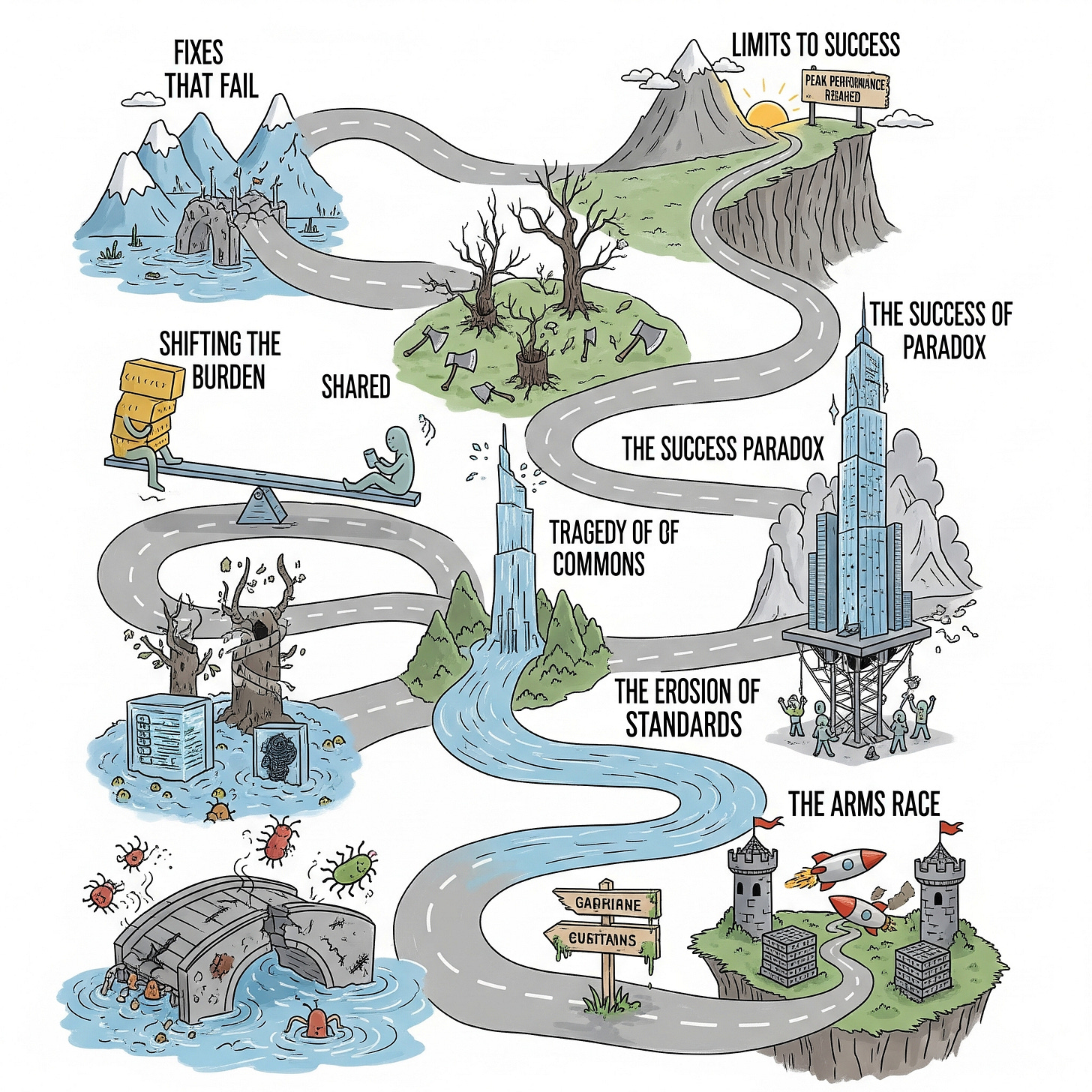The Hidden Dynamics of System Relationships
The map of the common system archetypes traps, adapted to software engineering and maybe also into organizational settings
"How did we end up here?" is a question that we often get to ask ourselves. Over the past few weeks, we've explored the intricate patterns that emerge when different parts of our systems need to work together. Let's recap what we've learned about these relationships and why they matter more than ever.
The Evolution of System Relationships
Think about your current system. Chances are it started simple - a few clean boxes on a whiteboard, clear lines of communication, well-defined boundaries. Then reality kicked in. New requirements emerged. Teams changed. What began as a clear structure evolved into something more... interesting.
Through this series, we've discovered that this evolution isn't random. It follows patterns - some intentional, some emergent, all revealing something about how our systems actually work in the real world.
Understanding the Pattern Language
The Quick Fix Cycle
We started by exploring "Fixes That Fail" - that seductive cycle where today's solution becomes tomorrow's nightmare. Every team has lived through the Redis caching layer that was supposed to solve performance problems but ended up creating cache invalidation mysteries that would make Sherlock Holmes weep.
The Dependency Trap
Then we discovered "Shifting the Burden" - how our modern "there's a service for that" culture gradually erodes our core capabilities. Auth0 for authentication, SendGrid for emails, Stripe for payments... until one day you realize you're the integration specialist not really doing anything remotely like a product.
The Shared Resource Wasteland
"Tragedy of the Commons" revealed why that shared staging environment has been "temporarily broken" for three months, and why nobody wants to be the one to fix it. Everyone's problem becomes no one's problem, and shared resources become digital graveyards.
The Success Paradox
We explored how success itself can become your enemy. "Growth and Underinvestment" showed why the most successful companies often have the most terrifying infrastructure, and "Success to the Successful" revealed how winning teams create self-fulfilling prophecies that have more to do with structural advantages than actual merit.
The Erosion of Standards
"Drifting Goals" exposed the gradual boiling of quality standards - how "80% test coverage required" slowly becomes "we have tests for the important stuff" through a series of individually rational compromises.
The Arms Race
"Escalation" revealed how teams accidentally declare technical war on each other, competing to out-engineer one another until everyone's drowning in unnecessary complexity and CVDD (CV driven development).
The Strategy Trap
Finally, "Limits to Success" showed how our best strategies eventually become our worst constraints - when the microservices architecture that saved you becomes the distributed systems nightmare that's slowly strangling your team.
The Reality Check
Here's what working with these patterns has taught me: Context drives everything. Team dynamics matter more than technical purity. Organizational structure influences architecture more than we admit. Sometimes the "wrong" pattern is exactly right for your situation.
These aren't just abstract concepts - they're the hidden forces shaping every technical decision you make. Once you start seeing them, you can't unsee them. That deployment pipeline complexity? Probably "Fixes That Fail." The team that keeps getting the best projects? "Success to the Successful" in action. The shared database that's becoming unmaintainable? "Tragedy of the Commons" playing out in real time. Well, just try to retain your critical thinking though, sometimes it might not be, context … again.
The Bigger Picture
This journey into systems archetypes started for me with Donella Meadows' brilliant book "Thinking in Systems." If you haven't read it yet, stop what you're doing and go get it. Seriously. Meadows doesn't just explain how systems work - she reveals why they behave the way they do, and more importantly, where the leverage points are for changing them.
What I appreciated the most about Donella' work is how she shows that the most powerful interventions happen at the level of paradigms and mindsets, not just processes and structures. When you understand these archetypes, you're not just debugging your current system - you're developing the mental models to design better systems from the start.
Tools for Navigation
Understanding these patterns is just the beginning. When you're facing a complex situation, how do you know which archetype you're dealing with? How do you decide what to do about it?
This is where frameworks like Cynefin become invaluable. Dave Snowden's framework helps you understand what type of problem you're actually facing. Is this a complicated problem (where best practices apply) or a complex one (where you need to probe, sense, and respond)? Most of the archetypes we've explored live in the complex domain - which means the solutions aren't obvious, and you need to experiment your way to understanding.
For strategic navigation, Wardley Mapping provides another lens. Simon Wardley's approach helps you understand how different components of your system are evolving and where to focus your architectural decisions. When you're caught in a "Growth and Underinvestment" cycle, a Wardley map can help you see which capabilities are becoming commoditized and which ones are truly differentiating.
These aren't silver bullets - they're thinking tools that complement the pattern recognition we've been developing. Cynefin helps you understand the nature of your problem space, Wardley mapping helps you navigate strategic decisions, and systems archetypes help you recognize the recurring dynamics that emerge.
Your Turn
Now that you've seen these patterns, you can't unsee them. You'll start noticing them everywhere - in your codebase, your team dynamics, your architectural decisions, maybe even your personal projects.
The question isn't whether these patterns will show up in your systems (they will). The question is whether you'll recognize them early enough to do something about them, or whether you'll discover them after they've already shaped your reality in ways you never intended.
Start paying attention to the forces beneath the surface. When you see a technical decision that seems obviously right, ask yourself: "What system archetype might this be part of?" When a strategy that's been working starts to feel harder to execute, wonder: "Are we approaching the limits of this approach?"
Most importantly, remember that these patterns aren't deterministic. They're tendencies, not laws. Understanding them gives you the power to work with them, around them, or sometimes to break them entirely.
The Hidden Dynamics Continue
Systems thinking isn't a destination - it's a way of seeing that keeps revealing new layers of understanding. These eight archetypes are just the beginning. There are more patterns to explore, more dynamics to understand, more ways that the complexity we create shapes the reality we experience.
The systems you build today will exhibit behaviors you never intended. The question is whether those behaviors will surprise you, or whether you'll have developed the mental models to anticipate, understand, and influence them.
Keep thinking in systems. The complexity isn't going away, but your ability to navigate it can keep growing.
What patterns are you starting to notice in your own systems?
#SoftwareArchitecture #SystemsThinking #ComplexSystems #ArchDeck
This concludes our exploration of how systems archetypes manifest in software architecture. Each pattern revealed hidden forces that shape our technical decisions - usually in ways we never intended. Understanding these dynamics is the first step toward designing systems that serve our intentions rather than subvert them.











